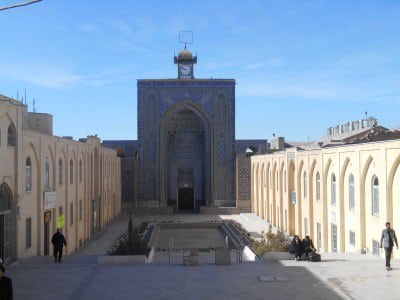Kerman is never going to be the most obvious Iranian city you visit, however that doesn’t mean you should leave it off your itinerary.

Architecture in Kerman
While a lot of people use Kerman as a gateway to the desert or en route to Pakistan, others find solace in the variety of sights around the city. You can walk yourself around the city centre area easily, but organizing a local driver to take you to a few sights further out is recommended.

Kerman
Bazaar e-Sartasari (end to end Bazaar)
A long bazaar graces the city centre of Kerman. From the entrance near Shohada Square, walk yourself right through the market here. A wide variety of stalls and shops sell hot food, fruit, vegetables, meat, jewellery, clothes and just about everything that markets in Iran are most known for.

Take a walk along the massive end to end Bazaar in Kerman, Iran.
Kerman National Library
The library has a stunning entrance and front, complete with alcoves lining the wall make this a decent spot to stop off at and reflect for awhile.
Masjed-e Jameh (Jameh Mosque)
Every big town or city in Iran has a Jameh Mosque and they vary from town to town. Kerman’s one sits pretty and untouristy just off Shohada Square. As always, you need to remove your shoes to go inside.
Gonbad-e Jabaliye
This unusual and remote octagonal building is somewhat of an enigma. Locals are unsure of its purpose, with rumours that it was once an observatory or a tomb. These days it’s a museum and a stand out building to admire on the edge of the city.
Kerman Fortress
On a rugged rocky mini mountain on the edge of town sits a once spectacular fortress. There’s a telecommunications tower on it these days and you can’t really access it – viewing from afar is your best bet.
Yakhchal Moayedi (The Ice House)
Yes, peculiar place names are the norm here in Kerman. This obscure looking building appears to be built of brown brick on first impression. Up close, you’ll see it’s made of hardened mud. It’s a massive structure which was once used to store ice. Well in a desert city, with a low level of rainfall it makes sense. Nowadays the place doubles as a museum, art gallery, tourist information centre and a mini theatre.

Kerman Ice House
Zarthosht Museum (The Fire House)
Yes – to even things up, there is a fire house here with an equally quirky name. In a Muslim country, a never ending fire sits in the middle of this house. In a separate building sits a less than exciting museum.

The fire that never goes out.
Golshan Caravanseri
This term “caravanserai” is something I’ve got used to recently while touring cities and towns that were once on the “Silk Road”. We stayed in a Caravanseri in Seki in Azerbaijan.
Vakil Traditional Tea House
This is a tea house inside a former bath complex. On your travels, this makes an excellent place for a culpa. Locals will come over and chat away to you as you sip tea. We also indulged in smoking some shisha and a local guy gave me some of his (alcohol free) beer. It is an extremely relaxing tea house in a well decorated room. Tea costs 10,000 Rials and the Shisha is around 70,000 Rials.

Enjoying some shisha and tea in a former bath house.
Hamam-e Ganj Ali Khan (Old Baths)
Hamam is the word bathhouse in parts of the Middle East and this one is Kerman’s oldest Bath House. However it’s no longer used as a place to bathe, so you can head in and check out a “Bath Museum” instead.

The bath house in Kerman.
Be sure to check out WBTW’s Middle East section and Iran page as well.

Jonny Blair is a self confessed traveling nomad who founded and blogs at Don’t Stop Living. He sees every day as an adventure. Since leaving behind his home town of Bangor in Northern Ireland ten years ago he has traveled to all seven continents, working his way through various jobs and funding it all with hard work and an appetite for travel. Don’t Stop Living, a lifestyle of travel’ contains over 1,000 stories and tips from his journeys round the globe. He wants to show others how easy it is to travel the world, give them some ideas and encourage them to do the same but most of all he aims to constantly live a lifestyle of travel. He is currently based in Hong Kong and on Twitter @jonnyblair.








